Mount Graham is a hulking mass of rock and forest rising from Arizona’s desert floor more than a mile and a half into an infinite sky. The Western Apache call it Dził nchaa si’an, which roughly translates to “big mountain sitting there.”
Apache deities known as gaan dwell on the 10,720-foot summit, overseeing territory that has been holy to the Apache for as long as they can remember.
In October 1990, despite repeated objections from local Apache tribes, the United States Forest Service—a federal agency that for many Apaches represents genocidal oppressors—started clear-cutting an eight-acre site on Mount Graham’s summit, destroying part of a pristine alpine forest that was a rare environmental relic from the last Ice Age. That’s when San Carlos Apache tribal member Wendsler Nosie Sr. decided it was time to fight—and not just the Western way with meetings and lawsuits, but the Apache way.
He started to run.
Mount Graham had become a center of controversy in the 1980s when it caught the eye of the Vatican. As far back as the late 1700s, the Catholic Church had conducted astronomical research via telescope from an observatory at the Vatican to verify the holy calendar. In the 1930s, the facility was relocated outside Rome, but by the early 1980s, light pollution was impeding visibility. Jesuit astronomers dispatched by Pope John Paul II to observe the heavens decided that they wanted Dził nchaa si’an, with its dark skies and mild desert climate, to be their perch for a new telescope. Land couldn’t be sacred, they said. Never mind the gaan.
The planned Vatican telescope was part of an ambitious $200 million proposal from the University of Arizona to create Mount Graham International Observatory with 13 telescopes located on Apache territory managed by the U.S. Forest Service. The observatory would also include the world’s largest optical telescope.
Among the project’s biggest champions was Father George Coyne, a Jesuit priest who was director of the Vatican Observatory and an astronomer at the University of Arizona. In addition to the Vatican and the University of Arizona, other U.S. universities had invested in the project, as had deep-pocketed astronomical research institutes in Italy and Germany.
Accounts vary, but Nosie says the traditional caretakers of Dził nchaa si’an were not consulted about the observatory, or even officially notified by the federal government, until plans were well under way. Initially the Forest Service dismissed their concerns, says Nosie, who was 27 at the time and served on the San Carlos Apache Tribal Council.
On July 10, 1990, spurred by grassroots opposition led by Apache activist Ola Cassadore, the San Carlos Apache Tribal Council passed a resolution against the construction of the observatory, calling the project “a display of profound disrespect for a cherished feature of the Apache’s original homeland as well as a serious violation of Apache traditional religious beliefs.”
The resolution was sent to the Catholic Church and the U.S. Forest Service. The project moved forward anyway.
This is how things had nearly always played out for the Apache since European immigrants began colonizing their territory. The colonizers would behave as if they were entitled to any place they decided had value, whether it was for minerals or timber or water. Now they wanted the sacred home of the gaan for unfettered access to the stars.
At the time, Nosie was the father of five children and worried for their futures as well as for his fellow tribal members, many of whom lived in poverty and struggled with diabetes and substance abuse. He was certain that if their sacred mountain was harmed, it would further endanger the spiritual and physical well-being of Apache people, which was entwined with the environmental health of their Indigenous homeland.
Wendsler Nosie wanted to ask for help from the gaan, but knew he had to follow traditional protocol or his prayers would fall flat. That meant he needed to approach the holy place on foot. In Apache culture, running is breathing. Running is praying. Running is the very essence of communion with the earth.
Running, Nosie had come to believe, would be one of the best ways for Apaches to fight the threat on Mount Graham.
“[It] is the way I had to go back,” Nosie says. “I would have to reintroduce myself [to the mountain] because we had been exiled out of there. The deities [would] know that I was sincere.”
Over a period of two days in October 1990, covering some 20 to 30 miles each day, Nosie ran from the desert of the San Carlos reservation to the summit of Mount Graham. The elevation gain was more than 8,000 feet. Along the way he passed through what he calls “corridors,” physical and spiritual passageways transitioning from saguaro to juniper to pine to alpine fir forests.
In accordance with the Apache belief system, Nosie integrated himself with the environment. He communicated with the plants and animals as he ran, and they sent messages ahead on his behalf. The saguaro told the juniper he was coming. The juniper told the ponderosa pine. And the ponderosa pine told the Engelmann spruce. Eventually, the deities got word.
It was very hard, says Nosie. “I was not like the people of the old who could cover 80 miles in a day. It showed me how modernization has affected me physically.”
Nosie had other epiphanies as he ran. “I realized so much about our identity and where we originated from and the sacredness of what makes us who we are, what’s holy,” he says.
Running and all that it was connected to would become a path to recovering a lost identity for generations of the Nosie family and other Apache tribal members. Not because running allowed them to gain media attention or prove a point or achieve a physical feat, but because running was the only way to tap into the physical and spiritual power that defined the Apaches before they were exiled from so much of their homeland.
Nosie would go on to become tribal chairman of the San Carlos reservation, and he continued to run in the years after his first journey up Dził nchaa si’an, every step connecting him physically and spiritually to the territory of his ancestors. Unlike the flat desert tableland where most San Carlos people lived, the original home of Nosie’s ancestors is a rippling landscape of rugged mountains carved from knife-edged metamorphic rock, deep canyons, and hidden springs.
Sometimes Nosie would run with his older brother Tommy and sometimes with his children. But often he was alone, accompanied only by the spirits that animate the Apache belief system where humans and the environment are one. The Apache word for land, ni’, is also the word for mind.
“It helps you understand how God created the world,” Nosie says about how those early runs shaped him, referring to Usen, the Apache word for Creator. As he traveled across vast mountainous terrain, he also learned what it meant to be truly free like his ancestors had been.
The traditional social structure of the Apache people evolved around territorial bands that occupied defined areas where they foraged for seasonal plants and wild game and farmed native crops like corn and squash. The bands were further divided into extended family groups that often lived miles apart from each other.
The Nosie family and most other members of today’s San Carlos tribe are descended from a handful of bands collectively called Western Apache, along with a smaller number of members descended from Yavapai and Chiricahua Apache bands. The traditional homeland of these Apache bands spanned more than 11 million acres, stretching from northern Mexico into upland portions of central and eastern Arizona.
Running was one crucial way Apaches stayed in communication with their relatives. Young men were trained to be superior distance runners and would often cover 80 to 100 miles a day delivering vital information about things like food, threats, and ceremonies. Consequently, every Apache band made it a priority to ensure that they had elite runners in their communities.
“[It] was one of the first things taught to us,” says Ramon Riley, a member of the White Mountain Apache Tribe and its longtime cultural resource director. Children were told to run up a mountain and back with a mouthful of water. “If you swallowed that water, that means you needed a lot of practice,” Riley says. “It was part of Apache life that was instilled in us since time began.”
When children were older, they went on a solo prayer run under the direction of an elder. “They were told to run to get a vision and gain knowledge of what they should do as people of the natural world,” says Riley, who is now 80. “Our whole way of life revolves around being people of the natural world.”
European colonizers created another important reason for the Western Apaches to maintain their running tradition. “We were always being chased,” says Riley.
When one of Wendsler Nosie’s granddaughters, Naelyn Pike, was in high school in Globe, Arizona, near the San Carlos reservation, she was drawn to the story of an Apache warrior who possessed legendary strength, a woman named Lozen who is rarely mentioned in history textbooks.
Lozen and her brother, the Apache warrior Victorio, were from the Warm Springs band that roamed New Mexico, southern Arizona, and Mexico. From 1879 to 1880, Lozen joined Victorio in fierce battles against the U.S. Cavalry and the Mexican Army that ended with Victorio’s death. Lozen later joined Chiricahua Apache leader Geronimo in his campaigns against the U.S. Army.
Naelyn would think about Lozen as she trained for cross-country meets or during private prayer runs. “Lozen would say that her only friends were her legs,” says Naelyn. “Lozen survived because she was a good runner. Running is how my people survived. If we didn’t run, we were dead.”
While the Western Apaches had mostly evaded European colonizers since the 1600s, it became especially difficult in the mid to late 1800s, when gold and silver were discovered in their rugged mountain homeland. Suddenly they faced opportunistic prospectors in search of mineral riches. The prospectors and their communities monopolized Apache water sources and inhibited the Apaches’ ability to forage for plants and hunt game. The Apache responded to encroachment on their territory by raiding settlements.
Tales of these battles created a distorted image of the Apache as violent and bloodthirsty. “The Apache is as near the lobo or wolf of the country of any human being can be to a beast,” an 1859 article in the New York Times declared.
When the Civil War ended in 1865, the Army turned its attention to protecting mining operations and settlers in the Arizona Territory against Apache raiding. In 1871, President Ulysses S. Grant assigned Civil War general George Crook to command the Department of Arizona and tasked him with overseeing the newly established 7-million-acre White Mountain Reservation for all Western Apache bands in the eastern part of the state. Crook ordered soldiers to kill any Apaches found off the reservation.
While many Apaches stayed on the reservation, others did not. And they were very hard to catch.
Crook’s cavalrymen were no match for nimble mountain runners like Lozen and Geronimo. Of trying to chase down Apache resisters, a former army officer wrote in a letter to a Missouri newspaper, “…they know every water-hole and every foot of ground in this vast extent of country; they have incredible powers of endurance… It is no exaggeration to say that these fiends can travel seventy miles a day… over the most barren and desolate country imaginable. One week of such work will kill the average soldier and his horse; the Apache thrives on it.”
To subjugate the Apaches and keep them from leaving the reservation, in 1875 the Army moved almost all Apache bands to a desolate patch of desert within the reserve called Camp San Carlos. It was manned by armed guards. Soldiers working there nicknamed it “Hell’s 40 Acres,” and thousands of Apaches were forced to live side by side in traditional domed brush shelters called wikiups. They were treated like prisoners. The male head of each household was required to report for roll call every morning; rations were doled out weekly.
Deprived of their traditional diet of wild greens, roots, nuts, seeds, and game, the Apache had to live off unfamiliar food with less nutritional value: Beef, flour, lard, sugar, coffee, and salt. Bootleg whiskey also became a staple. Missionaries arrived to convert them to Christianity, and the Apache were not allowed to practice their ceremonies or any visible form of spiritual traditions. All the reasons for running that had been central to their pre-reservation life were gone.
“Apaches were the one tribe that were treated so harshly,” says Bob Stevens, an Apache historian and member of the San Carlos Apache tribe. Stevens, 58, is also an avid runner and a certified Apache language instructor. “My ancestors went from being a totally free people who could hunt and gather and travel wherever they wanted to living in confinement.” Many Apaches who were born in captivity on San Carlos were sent to Indian boarding schools, where they were prohibited from speaking the Apache language or practicing their spiritual traditions.
Meanwhile, from the 1870s to the early 1900s while the Apaches were confined to San Carlos, the U.S. government opened nearly half the White Mountain Apache reservation land to miners, loggers, and Mormon settlers. Mount Graham, which had been part of the reservation, was turned over to the Forest Service; it was then heavily logged and thoroughly plumbed to deliver water to non-Apache communities.
By 1897, after the Apache Wars were over, the U.S. government allowed those confined to Camp San Carlos to relocate to Arizona reservations. The Western Apaches were consolidated by the government into three federally recognized tribes, with reservations in eastern and central Arizona: San Carlos Apache, White Mountain Apache, and Yavapai-Apache, all of whom descended from those confined at Camp San Carlos.
The confinement has had lasting effects. Stevens, who has lived his entire life on the San Carlos reservation, says it changed the Apache people, and the trauma his ancestors experienced is still evident today. “Diabetes is rampant, so is alcoholism,” he says. “Drug use is getting worse. Suicide rates are high.” He also worries about the loss of the Apache language: Nearly everyone in his grandparents’ generation spoke fluent Apache, but among his grandkids’ generation, he says, it is less than one percent.
Stevens is involved in a language preservation program for the San Carlos Apache tribe, which he says is central to perpetuating the culture. Because of the restrictions placed on them, “my parents’ and grandparents’ generations had it the hardest,” says Stevens. “My generation is finally able to choose [the Apache way], but it may be too late to go back to the things we used to practice.”
It is as if the Apaches living on the reservations today are still captive. But Wendsler Nosie Sr. wants his fellow tribal members to know that they can literally run off the reservation if they choose to do so. They can transcend the barbed wire of historical trauma and reach the Apache holy places. It is what Nosie calls “going home.”
Vanessa Nosie remembers what it was like growing up in a family of runners. Now 42, she is the eldest daughter of Wendsler’s six children. In the late afternoon when the desert heat finally let up, the extended family would set out together on the dusty dirt roads, over sandy hills covered with prickly pear and creosote bushes. When people saw the group cresting a hill on foot, they would joke that the family looked like a herd of deer.
“We would just go, everyone, as a family,” she says. “There were teachings in those runs about our history, our family, our people. It tied us to our ancestors who gave the same teachings to their kids.”
Wendsler attributes his family’s emphasis on running to his mother, Elvera Nosie, who wanted to reclaim her Apache traditions and pass them on to her children. When she died in 2016, she was the matriarch of a family that encompassed her seven children, 47 grandchildren, 124 great- grandchildren, and 30 great-great grandchildren.
Like Stevens, Wendsler’s parents and grandparents were born in captivity. Elvera’s ancestors came from the Yavapai and Tonto Apache band that lived in central Arizona. In February of 1875, U.S. Army soldiers forced them to march 150 miles to San Carlos. Wendsler’s father, Paul, was descended from the Bedonkohe band of Chiricahua Apache who were forced from their homeland in southeastern Arizona to live at San Carlos. Paul supported the family by working at an asbestos mine. He died of leukemia when Wendsler was 7.
“My mother always… said you have to be physically sound in order to have a clear mind for everything you are going to do,” says Nosie. “My mother saw how our people were made dependent and all these essences [were taken] away from them, and that is how all this disease came in like diabetes. That hampered every spiritual part of who we are.”
Just as the Apache did 150 years earlier when they fought the invasion of their homeland, they would need physical and spiritual strength to battle the observatory project on Mount Graham.
In 1991, with the blessing of the San Carlos Tribal Council, a group of Apache activists brought a lawsuit against the University of Arizona and the U.S. Forest Service to stop construction of the telescopes on Mount Graham. Nosie and other traditionalists took a spiritual approach alongside the tribe’s efforts to raise public awareness by fighting in court. The suit claimed that the intrusion of the observatory on the Apache’s sacred mountain interfered with their ability to practice their religion.
In an affidavit for the lawsuit, the Vatican Observatory’s director, Father George Coyne, stated: “After extensive, thorough investigations by Indian and non-Indian experts, there is to the best of our knowledge no religious or cultural significance to the specific observatory site. If the objection is pressed on the grounds that the observatory is merely on the mountain, then, why has there been no outcry concerning far more widespread encroachment on other, higher peaks and on demonstrable prehistoric sites?” Coyne maintained that the Apache were being unreasonable.
Ultimately, the Ninth Circuit Court of Appeals sided with the Western version of spirituality.
The Vatican telescope was completed in 1993. A second one, the $120 million Large Binocular Telescope operated by the University of Arizona and the Max Planck Institute, was dedicated in 2004. Originally called “the Columbus Project” by its investors, it was the largest optical telescope in the world when it was completed.
Despite the defeat, the Mount Graham Sacred Run became a 30-year tradition that attracted Apaches and other Native Americans who wanted to reconnect with their traditions and protect their sacred places, as well as environmentalists who objected to the observatory.
Dwight Metzger was one of them. In 1992, he was protesting tree cutting at the observatory construction site. He and other protesters had chained themselves by the neck to bulldozers when Apache tribal members, including Wendsler Nosie, approached them.
“We told them they needed to settle down,” Nosie recalls. They had good intentions, he says, but they were not going about things in a spiritual way.
So Metzger refocused his efforts on supporting the Apaches in their struggle for sovereignty over their homeland. He has participated in the Mount Graham run nearly every year since 1992 and says it has transformed his relationship to nature.
It is typical in white culture, he says, “to dominate or conquer or achieve something. We sometimes put those achievements into our relationship with nature, whether it’s climbing a 14,000-foot peak or running a marathon. What’s missing from that mentality is realizing the journey along the way—not in terms of the scenery, but being truly integrated into the place and the context of the lands we are in.”
There is a big difference between what is required for running up Mount Graham with a Western worldview versus running up Dził nchaa si’an the Apache way. “One thing I’ve learned about going to Mount Graham is you have to be ready,” says Metzger. “I haven’t always been ready in my heart and my mind. That’s something you can’t train.”
The relay, which covers the 100 miles from the historic site of Old San Carlos to the top of Dził nchaa si’an, is not a race. It’s a communal ritual with runners riding in a pickup truck waiting their turn to carry an eagle feather staff up a steep, switch backing road. A traditional sweat lodge is often held the day before the run. Prayers are said nearly continuously.
“We didn’t stop all the telescopes on Mount Graham,” says Metzger. “But it is the most beautiful victory to see generations of Apaches since 1988 growing and coming back to it every year in bigger numbers.”
The cultural implications have been significant. In 2013, Vanessa Nosie’s daughter Naelyn held her traditional Coming of Age ceremony (to celebrate her first menstrual cycle) in a meadow high on Dził nchaa si’an. Vanessa says it was the first time the ceremony had taken place on Mount Graham in more than 150 years.
The ritual requires the girl to run every morning for four days. “When I think about running Mount Graham, I imagine my ancestors running behind me,” says Naelyn, who easily ran 10 miles each day. “It was as if their spirits were with me because they wanted to go home too.”
On a crisp afternoon in October 2021, three generations of Nosies sit under a centuries-old oak tree at a place Wendsler calls the holy ground. It is the site of the latest, and arguably the biggest, Apache battle of the 21st century.
Chí’chil Biłdagoteel, or Oak Flat, with its grove of ancient Emory oak trees, is sacred to the Apache, a place where Apache ancestors performed ceremonies and gathered food and medicinal plants. But the land is also the site of one of the largest untapped copper ore deposits in the world. In 2014, the U.S. government agreed to turn over Oak Flat to an international mining conglomerate as part of a land swap.
The Nosies and other Apache activists are waging a war to stop the mine. Through a grassroots organization they founded called Apache Stronghold, they filed a lawsuit against the Forest Service that is currently before the Ninth Circuit Court of Appeals. A decision about whether the land swap can move forward is expected this year. As with the lawsuit over Mount Graham, Apache Stronghold maintains that having the sacred Chí’chil Biłdagoteel obliterated by a mine is an infringement on their ability to practice their religion.
Unlike the Mount Graham fight, however, this one is supported by numerous Christian organizations that endorse Apache Stronghold’s quest to have Native American spirituality treated the same as other religious traditions. Notre Dame law students filed an amicus brief in U.S. district court on behalf of the Apaches’ right to religious liberty. Students from Brophy College Preparatory, a Jesuit high school in Phoenix, ran 188 miles to Oak Flat in February of 2022 to raise awareness for the cause. Apache Stronghold also holds annual march/runs from San Carlos to Oak Flat.
Nosie, 62, sits at a picnic table at Oak Flat campground with his brother Tommy, 67, as well as his daughter Vanessa and granddaughters Naelyn and Baase, who is 17. Wendsler recalls passing the campground while traveling with his mother as a boy: “My mom used to stop here at Oak Flat real quick to pick up acorns and to pray.”
Times are different now. The younger generation of Apaches is no longer afraid of the colonizers. The Mount Graham run and now the Oak Flat fight has broken a lot of barriers for them, says Wendsler, pointing to Naelyn and Baase. Running has brought us back to who we were before the reservation, he says.
In November 2019, as the threat of the copper mine taking over Oak Flat continued, Nosie decided to relocate from the San Carlos reservation to his ancestral home at Oak Flat. He would live at the campground to protect the sacred site. And he would get there on foot.
His granddaughter, Baase, then 15 and a varsity member of her high school cross-country team, insisted on running with him.
Nosie says he never would have made it without her. “There were times I wanted to stop, but Baase’s belief in front of me pulled me,” he says.
It was a three-day, 40-plus-mile journey. They ran through sleet and camped in snow. They stopped at each spiritual corridor to pray and ask for permission to proceed. The saguaro told the agave they were coming. The agave told the juniper. And the juniper told the centuries-old Emory oak. It had been a long time since Apaches had lived under that tree.





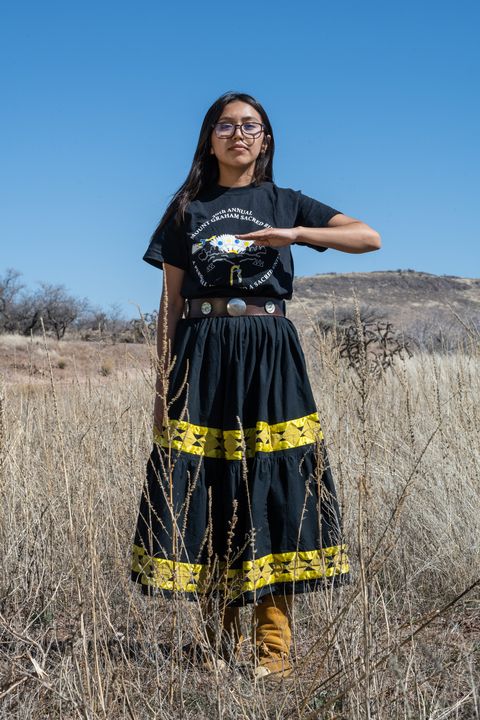
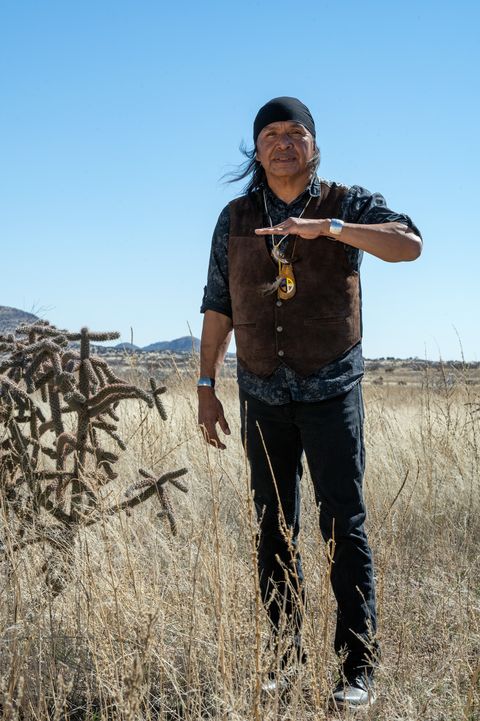

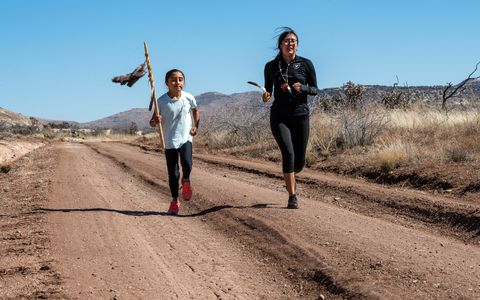


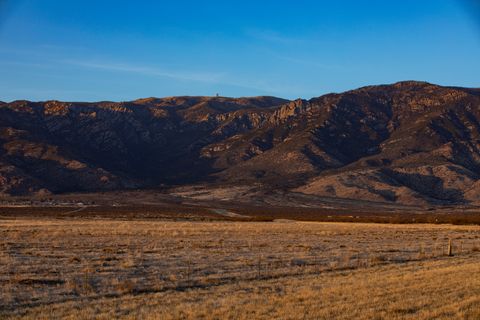
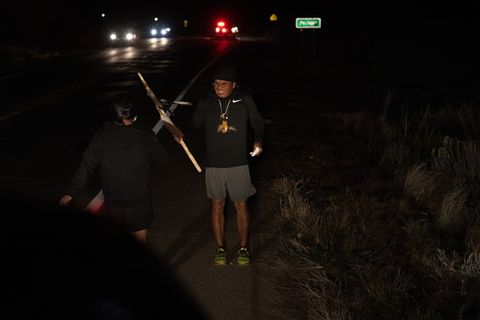



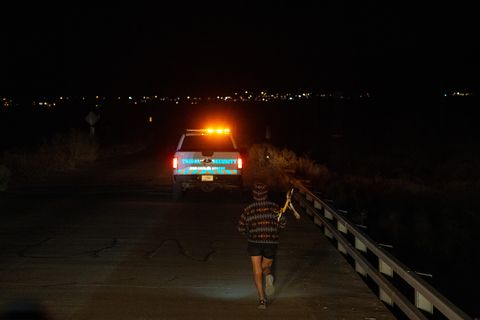


More Stories
Cape Town’s Big Six: Table Mountain
5 Essential Tips For Hiking With Kids For The First Time
This Is Why You Need To Go To Mt. Kenya – Part 4